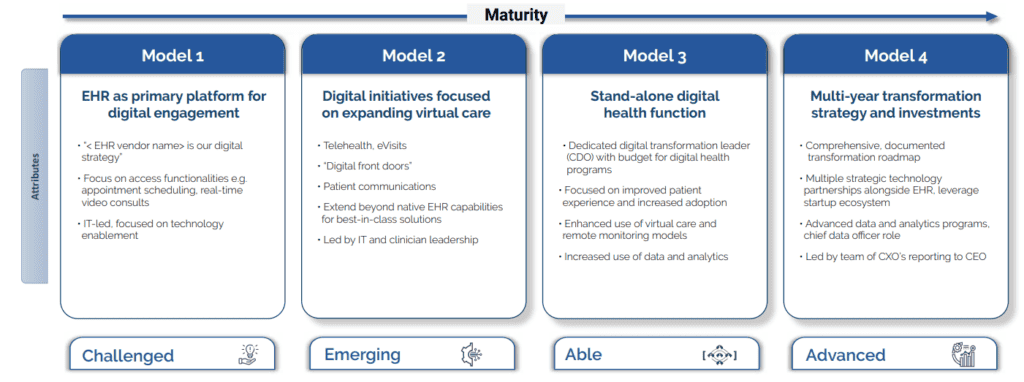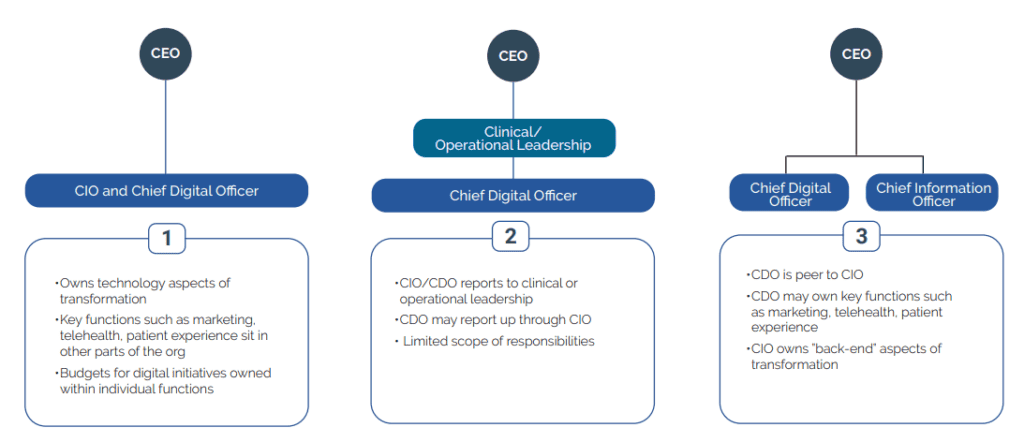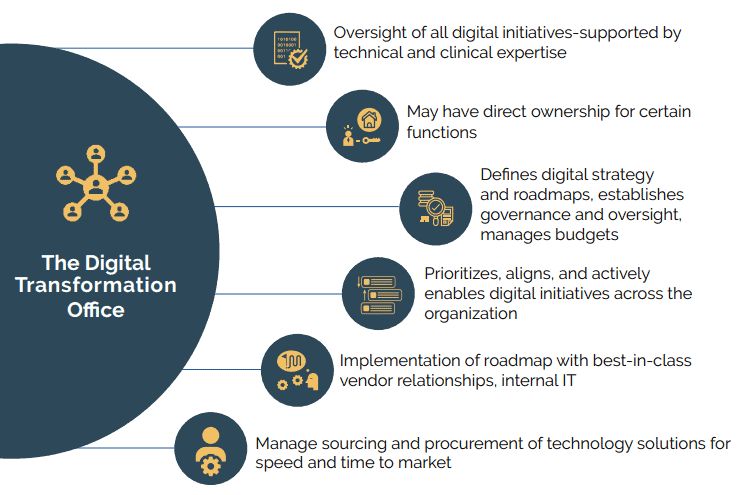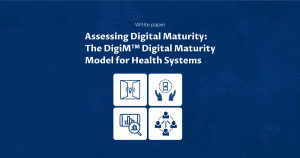POV
Governance Models and Best Practices for Digital Transformation in Healthcare Enterprises

Introduction
As the digital transformation of healthcare accelerates, healthcare enterprises are investing in robust governance structures in place to trac progress, measure impact and ascertain the benefits from their investments. Damo’s DigiMTM framework provides a framework for assessing health systems based on a range of attributes. The framework, described in the visual below, assesses health systems on four dimensions – maturity in the deployment and adoption of digital engagement tools for patients and providers, maturity in digital programs for care management and virtual care models, adoption of enabling platforms such as cloud and CRM for supporting digital transformation, and finally, maturity in organization models and governance.
Digital Maturity Models for Health Systems

Based on data
Based on data from digital maturity assessments by a large number of health systems using the DigiMTM framework and Damo’s research.
Identified
We have identified a number of best practices related to organizational models and governance.

Digital transformation budgets are not IT budgets: The leading enterprises are focused on deploying technologies that enable consumer, patient and caregiver/employee engagement. Common digital themes include patient portals, consumer mobile apps, intranet site, virtual care management, unified “single pane of glass” websites, service management platforms, customer relationship management (CRM), provider communication tools, and more. Cloud migration budgets are often included in the scope of digital transformation, indicating the need for organizations to invest in reliable, scalable and agile infrastructure. Data and analytics capabilities, especially around consumer data platforms (CDP) is an emerging area of focus that underpins the shift towards an increasingly consumerized model of healthcare services. Importantly, the budgets are not categorized as IT budgets, a distinction that serves to highlight the significance of digital initiatives as a primarily a business transformation exercise that goes far beyond the scope of the IT function.
Based on our benchmark data, nearly 70% of leading health systems across the nation have formalized their digital transformation programs under a digital function. Many have had a digital function in place since before the pandemic struck in early 2020. However, only in half of the health systems in our benchmark data, the digital function/leader reports up directly to the CEO of the organization. The majority of enterprises have some form of a documented digital strategy/ roadmap.
The digital maturity of an organization is directly correlated to how the digital function is set up, how digital investments are prioritized and how the digital function is governed. Health systems are largely in early stages of maturity when it comes for formalizing and governing the digital function as a C-suite strategic imperative.
We see several best practices in establishing and governing the digital transformation across leading enterprises that can serve as a blueprint for organizations in early stages of their digital journeys.
Stewardship principle: In leading organizations, the digital function functions as a steward of the technology vision and supports the digital health roadmap in collaboration with operational leaders and IT. very often, the focus of the digital function is to support virtual care and digital front door strategies in providing a comprehensive patient experience through multi-channel patient access and engagement.
Digital Transformation Office (DTO): In many health systems, a Digital Transformation Office (DTO) often steers digital initiatives and operates in a hub-and spoke model under a dedicated leader. The digital leader performs a stewardship role and oversees digital programs in collaboration with digital/technology teams across enterprise, such as medical groups, marketing, digital patient engagement, and telehealth/virtual care. The DTO works with foundational units to evaluate emerging digital tools, evaluate the readiness of internal stakeholders to adopt those tools, and work closely with the IT leader to help implement those tools as part of a transformative change.
C-level/Board level sponsorship: Our research and benchmark data indicate that digital transformation programs in the leading enterprises are established and governed at the senior most levels of the organization. The leading systems have obtained board-level commitments for multi-year transformation initiatives and have in many cases appointed a dedicated leader to oversee digital. There is considerable variation in the responsibilities of the digital leader across organizations. In the most advanced organizations, there is a Chief Digital Officer (CDO) who works in close co-ordination with other C-suite leaders such as Chief Information Officer, Chief Transformation Officer, and Chief Innovation Officer, all of whom report up directly into the CEO. In others, the CDO is either focused on specific aspects such as patient engagement, or performs the CDO role in a part-time capacity, often with other clinical or operational responsibilities. In such cases, the CDO usually does not report directly to the CEO, reflecting a lack of strategic importance/priority to digital transformation at the enterprise level.
The current digital transformation budget is utilized for approximately 20 projects across 6 key areas: Digital Front Door Service Center of the Future Digital Clinical Transformation Employee Digital Engagement Command Center Patient Financial Journey

- Paddy Padmanabhan
CEO, Damo Consulting Inc.
3 typically sits alongside one of the other models in large enterprises with dedicated innovation groups that focus on commercializing internal innovation and making strategic investments in startups.
Digital maturity in healthcare today falls mostly in one of the models described in Figure 1 above. Most health systems are in models 1 and 2, and a small number are maturing towards an enterprise approach and roadmap for healthcare digital transformation in model 4. Model.
The changing landscape has also forced healthcare enterprises to review their options when it comes to the organizational models required to drive healthcare digital transformation in the post COVID-19 era. What may have been primarily an IT-enabled capability is now a strategic priority that requires a deep appreciation of consumer experience journeys, cross functional collaboration to enable seamless experiences, and technology expertise to implement digital engagement priorities.
Figure 3 below indicates the various organizational models in practice today at healthcare enterprises. The leading organizations in the healthcare sector that have been investing significant amounts in a large scale transformation of the enterprise have dedicated Chief Digital Officer roles. In many cases, the CIO also plays the role of CDO; in others the CIO works in concert with other C-level executives to drive digital transformation; in yet others, the CDO role reports up into a CIO or other C-suite leaders. Regardless of the model, Healthcare CIOs across the board are deeply involved in enterprise digital transformation today. The range of organization models suggests an evolving landscape when it comes to driving digital.

The Digital Transformation Office

An interesting trend is a small number of health systems that are setting up healthcare digital transformation offices (DTO) to drive enterprise-wide digital transformation initiatives. Figure 3 below provides a typical charter for a DTO.
A DTO is distinct from a Chief Digital Officer role; in that it is a stand-alone function tasked with actively enabling healthcare digital transformation initiatives across the enterprise.
The DTO is typically led by a senior leader in the organization with:
- Significant influence across functions.
- The authority and empowerment to make critical decisions related to investments priorities.
- Technology platform decisions, and
- A board-approved budget to drive transformation.
The leader of the DTO may or may not have a direct ownership of individual functions undergoing transformation. A steering committee oversees the DTO, with strategic guidance on organizational priorities that in turn influence the DTO’s priorities and approves budgets for individual initiatives within the overall transformation program.
Other important functions of a DTO include:
- Bringing about a robust governance
structure to assign priorities for
sequencing individual digital initiatives, - Establish technology architecture guidelines,
- Standardize vendor selection and system selection process, and
- Provide project management support to functional leaders driving digital initiatives.
DTO leaders often turn to external consulting firms for support in executing on their mandate, partly due to limited internal resources, but also to tap into industry expertise, technology skills, and best practices. Complementing a lean internal team accelerates transformation through faster decision-making, structured approach to technology vendor selection, and an objective and fact-based approach to digital priorities.
One health system we worked with significantly accelerated their transformation with external assistance for initial set-up and program governance, established communication and review/reporting processes, defined a structured approach to technology architecture choices and partner selection, and more. The robust approach to DTO governance:
- Enabled well-informed technology choices,
- Delivered millions of dollars in scale economies and negotiated discounts, and
- Increased savings through cost avoidance.
By providing active support to functional leaders with busy schedules and day-to-day responsibilities, the DTO was able to rapidly advance several transformation initiatives.
For more information, write to us at info@damoconsulting.net
We invite you to visit www.damoconsulting.net
For additional content on digital
strategy, case studies of our work,
and ongoing research, subscribe to our newsletter and our highly rated podcast,
The Big Unlock.
As the digital transformation of healthcare accelerates, healthcare enterprises are investing in robust governance structures in place to track progress, measure impact and ascertain the benefits from their investments. Damo’s DigiMTM framework provides a framework for assessing health systems based on a range of attributes. The framework assesses health systems on four dimensions – maturity in the deployment and adoption digital engagement tools for patients and providers, maturity in digital programs for care management and virtual care models, adoption of enabling platforms such as cloud and CRM for supporting digital transformation, and finally, maturity in organization models and governance.














